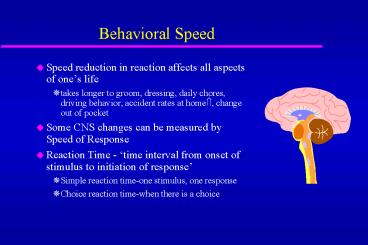Behavioral Speed PowerPoint PPT Presentation
1 / 17
Title: Behavioral Speed
1
Behavioral Speed
- Speed reduction in reaction affects all aspects
of ones life - takes longer to groom, dressing, daily chores,
driving behavior, accident rates at home?, change
out of pocket - Some CNS changes can be measured by Speed of
Response - Reaction Time - time interval from onset of
stimulus to initiation of response - Simple reaction time-one stimulus, one response
- Choice reaction time-when there is a choice
2
Can exercise muscular training contribute to
maintenance of motor control
- Human movement based on some minimal level of
muscular strength, endurance, flexibility - CNS more vulnerable to oxygen inadequacy than
other physiological systems - Cortical tissue cannot survive without oxygen for
more than 5-10 min - Maintenance of oxygen delivery system would seem
highly appropriate preventative behavior to
postpone premature aging (Spirduso, 1995)
3
Risk for Falling
- Impaired balance, slow inadequate postural
adjustments to changes in the environment, poor
leg strength, compromised locomotor patterns,
escalate the risk of falling
4
Coordination Skill in Complex Movements
- Complex movement/muscle patterns require practice
before skill - Coordination (define) - ability of eyes, hands
feet to accomplish goal - Integration of vision and hands while performing
task eye-hand coordination - Perceptual schema - internal model of environment
and input parameters - Motor schema - programmed to activate the
appropriate muscles to complete task
5
Sensory Function Related to Motor Control
- Information from the environment
- Sight, sound, smell
- Sensations from the body
- Touch, proprioception, pain, temperature
- Receptors in these systems provide info re type
of modality activated (sight, sound, smell) and
intensity, duration, and location of the
stimulus. - Sensory systems most closely related to motor
control are
6
Vision
- Vision provides information about
- Environment and location, direction and speed of
movement of individual - Visual and vestibular input trigger postural
reflexes to maintain balance and prepare for
movement - Associated w/aging are losses in
- Visual processing speed
- Dynamic vision
- Visual search
- Size of visual field
- Estimation of velocity
- Acuity in low illumination
- Accomodation reserve
- Resistance to glare
7
Vision
- Other changes occur
- Ability to detect the spatial relationships of
objects - Depth perception
- Peripheral vision
- All contribute to balance
8
Exercise Effects on Vision
- Little to no research has been conducted on the
effects of acute and chronic exercise on eye
physiology and visual function in either young or
old adults - What do you think?
- Type II Diabetes -? leads to retinopathy one of
the 3 leading causes of blindness
9
Vestibular Function
- Control postural sway
- Receptors provide a static vertical reference to
position head with respect to gravity - Vestibular neurons decrease in both number and
size with age (starting at age 40) - By 70 yr, 40 of sensory cells of system are lost
effect on function is equivocal - Depends on when (how old subjects are in study
10
Motor Skill Classification
- Discrete movements - recognizable beginning and
ending point - Unilateral, bilateral, repetitive, sequential,
aiming - Continuous motor skills
- Tracking, handwriting
- Multilimb skill
- Driving an automobile
- Functional skills
- Fine motor card sorting, typing, using eating
utensils, dialing a phone, picking up coins,
squeezing toothpaste, zipping a garment - Gross-motor shoveling, mopping, sweeping,
ironing, throw
11
Other Movements
- Continuous movements - No distinguishable break
in motion (no obvious beginning or end) - Steering wheel of car, writing
- Handwriting speed - declines with age - 60y
- Specificity of training
- Multilimb coordination - right hand control
maintained better - neurological redundancy in
left-hemisphere
12
Age Effects on Physical and Behavioral Attributes
Necessary for Driving
- Vision - 90 of information
- Dynamic acuity, acuity, size of useful visual
field, detection of motion in depth, detection of
angular motion - Eye-hand-foot coordination
- Compensatory changes in behavior of older drivers
- Drive significantly less
- Take fewer risks
- Drive more slowly
- Avoid driving in bad weather
13
Learning Physical Skills
- Older subjects learn simple skills relatively
quickly - the gap narrows with the young quickly - Tasks with continuous series of complex and
varied movements, more difficult to learn in
middle age and older adults - Reminiscence
14
Neural Plasticity Mechanism for Learning
- Older adults cannot eliminate age differences in
many coordinated motor performances with
extensive practice - Number of active motor units decreases with aging
- Motor performance can be improved
- Brain has ability to change structure function
15
Morphological Changes with Practice
- New contacts and neurochemical changes that
facilitate specific pathways are developed by
practice - Changes in number, cell structure, and density of
neurons accompany physical activity in animals - Size principle (Henneman et al., 1965)
- The fore and speed of contraction dictate the
recruitment pattern and firing rate of motor
units - Oxygen availability may influence the recruitment
of high threshold motor units - Moritani et al, 1992 speculated that when
skeletal muscle contractility is reduced due to
occlusion, muscle spindles and golgi tendon
organs signal for recruitment of more motor units
16
Morphological Changes with Age
- Neurons die
- Dendritic branches, thin and lose interneuronal
contact - Brain weight becomes lighter
17
Reflexes
- Reflex sets of elementary patterns of
integration activated or modified by sensory
stimuli or descending influence from brain stem
or cerebral cortex - Stretch reflex
- Flexor withdrawal reflex
- Righting reflex
- Myotatic reflex Achilles tendon reflex
monosynaptic contributes to control of sway
during standing and balance during locomotion - Reflexes represent neural integrity

